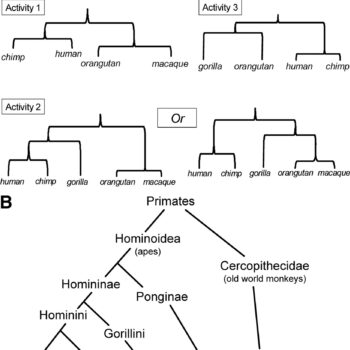Grade Level(s):
- 9-12
- 13-16
Source:
- Lents, Nathan, et al
Resource type:
- Lab activity
Time: 1 to 4 periods
Overview
Students explore molecular data from Homo sapiens and four related primates and develop hypotheses regarding the ancestry of these five species by analyzing DNA sequences, protein sequences, and chromosomal maps.

- [History of life: Grades 9-12] Through billions of years of evolution, life forms have continued to diversify in a branching pattern, from single-celled ancestors to the diversity of life on Earth today.
- [History of life: Grades 9-12] Life forms of the past were in some ways very different from living forms of today, but in other ways very similar. (LS4.A)
- [History of life: Grades 13-16] Through billions of years of evolution, life forms have continued to diversify in a branching pattern, from single-celled ancestors to the diversity of life on Earth today.
- [Evidence of evolution: Grades 9-12] Similarities among existing organisms provide evidence for evolution. (LS4.A)
- [Evidence of evolution: Grades 9-12] Anatomical similarities of living things reflect common ancestry. (LS4.A)
- [Nature of science: Grades 9-12] A hallmark of science is exposing ideas to testing. (P3, P4, P6, P7)
- [Nature of science: Grades 9-12] Scientists test their ideas using multiple lines of evidence. (P6, NOS2)
- [Nature of science: Grades 9-12] Scientists may explore many different hypotheses to explain their observations. (P7)
- [Nature of science: Grades 9-12] Accepted scientific theories are not tenuous; they must survive rigorous testing and be supported by multiple lines of evidence to be accepted. (NOS2, NOS4)
- [Studying evolution: Grades 9-12] Our understanding of life through time is based upon multiple lines of evidence.
- [Studying evolution: Grades 9-12] Scientists use the similarity of DNA nucleotide sequences to infer the relatedness of taxa. (LS4.A)
- [Studying evolution: Grades 9-12] Scientists use anatomical evidence to infer the relatedness of taxa. (LS4.A)
- [Studying evolution: Grades 9-12] Classification is based on evolutionary relationships.
- [Studying evolution: Grades 13-16] Evolutionary trees (i.e., phylogenies or cladograms) portray hypotheses about evolutionary relationships.
- [Studying evolution: Grades 13-16] Evolutionary trees (i.e., phylogenies or cladograms) are built from multiple lines of evidence.
- Disciplinary Core Idea LS4.A: Evidence of Common Ancestry and Diversity
- NOS Matrix understanding category 2. Scientific knowledge is based on empirical evidence.
- NOS Matrix understanding category 4. Scientific models, laws, mechanisms, and theories explain natural phenomena.
- Science and Engineering Practice 4. Analyzing and interpreting data
- Science and Engineering Practice 6. Constructing explanations and designing solutions
- Science and Engineering Practice 7. Engaging in argument from evidence
9-12 teaching tips:
This activity, suitable for laboratory, discussion, or any other group work setting, is broken into three parts. Each individual part could be modified, done at different times or stand entirely on its own. The discussion at the end of each activity is critical.
The inquiry-based student activity described herein is a novel approach toward the instruction of the practice of molecular phylogeny and systematics.
Though these activities were developed for the undergraduate level, no advanced quantitative skills or knowledge are necessary and therefore may well be suitable for high school students.
13-16 teaching tips:
This activity, suitable for laboratory, discussion, or any other group work setting, is broken into three parts. Each individual part could be modified, done at different times or stand entirely on its own. The discussion at the end of each activity is critical.
The inquiry-based student activity described herein is a novel approach toward the instruction of the practice of molecular phylogeny and systematics.
The activities are appropriate for introductory biology curriculum, for nonmajors, and even secondary education levels.
